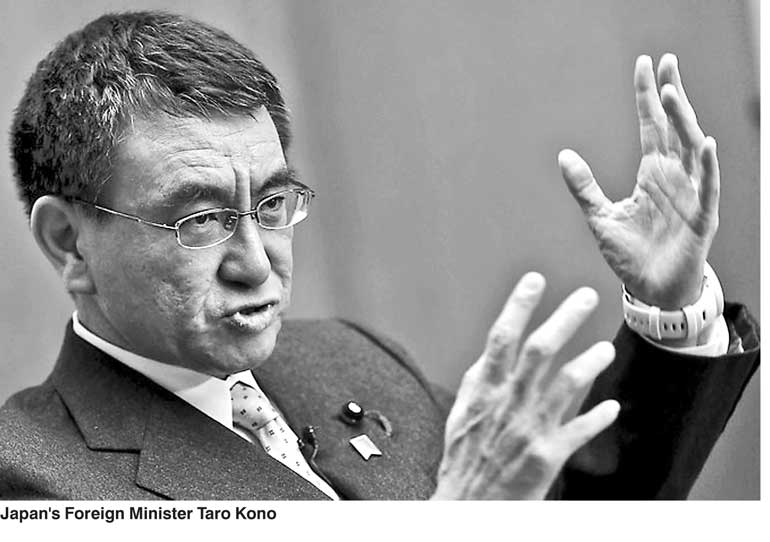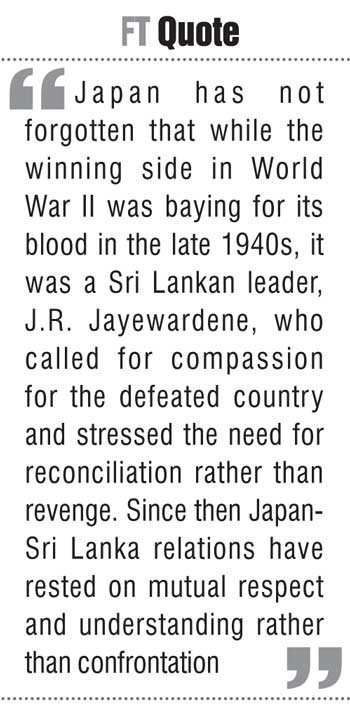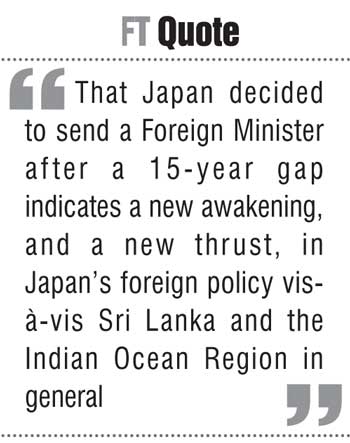Monday Apr 07, 2025
Monday Apr 07, 2025
Saturday, 30 December 2017 00:33 - - {{hitsCtrl.values.hits}}

The visit of the Japanese Foreign Minister Taro Kono to Sri Lanka on 5 January is going to be short – just a day. But it is of enormous significance for both Japan and Sri Lanka.
That Japan decided to send a Foreign Minister after a 15-year gap indicates a new awakening, and a new thrust, in Japan’s foreign policy vis-à-vis Sri Lanka and the Indian Ocean Region in general.
Facing an economic and strategic challenge from an emergent China in East, South East and South Asia, Japan feels that it can no longer take its economic dominance in these areas for granted and rest on its oars. Prime Minister Shinzo Abe, whose forceful re-orientation of Japan’s foreign policy got popular sanction in this year’s elections, is expected to pursue a multi-dimensional and forward foreign policy in East, South East and South Asia.
Given the already existing links between Japan and the US on the one hand, and Japan and the South Asian region on the other, Abe is keen to establish a strategic link between the Indian and Pacific Oceans with US, India and Australian support. Hence the evolution of a new concept, that of the Indo-Pacific Region, with a new organisation to safeguard its security interest called the “Quad”.
According to Admiral Dr. Jayanath Colombage, a Sri Lankan expert on maritime security, Japan sees Sri Lanka not just as a country where it can sell its products and assist in economic development but as a “strategic asset” in its cold war with pushy and domineering China. Very importantly, Japan feels that it is welcome in Sri Lanka, given the history of mutually-beneficial and fruitful relations.
Japan has not forgotten that while the winning side in World War II was baying for its blood in the late 1940s, it was a Sri Lankan leader, J.R. Jayewardene, who called for compassion for the defeated country and stressed the need for reconciliation rather than revenge. Since then Japan-Sri Lanka relations have rested on mutual respect and understanding rather than confrontation. This makes Sri Lankans view Japan as a “benign” power whose aid comes with no strings attached.
While the Sri Lankan polity has had reservations about the intentions of India and the US, because of a history of interference in the internal affairs of Sri Lanka, it has had no reservations about Japan which has scrupulously avoided interference.
Even during the 2002-2004 peace process, in which Japan was a key participant in addition to the US and EU, it tried to build and consolidate peace with economic development schemes rather than with political prescriptions.
Throughout his mission in Sri Lanka, Japan’s Special Peace Envoy, Yasushi Akashi, scrupulously avoided antagonising the Sri Lankan Government. He respected its sensitivities, unlike the West, which had a political agenda to pursue.
Japan was Sri Lanka’s top most aid giver till recently when China took over. From 1965 to date, Japan has given aid (concessional loans, grants, and technical assistance) to the tune of Rs. 1,628 billion. This may not be a big amount, but all of it has gone into socially relevant projects which touch the common man, especially persons belonging to vulnerable sections and those in the backward regions. Japanese assistance has also been non-controversial as the projects are not massive with huge financial outlays.

Current projects include the Bandaranaike International Airport development scheme; improvement of electricity generation and distribution; rehabilitation of the Kilinochchi water supply system; construction of a research and training complex in Jaffna University’s Agriculture Faculty; demining in the war-affected Northern Province; the Kelani river bridge project; measures to prevent congestion in the megapolis which is being planned; and capacity building through provision for training of Sri Lankan functionaries.
Prime Minister Ranil Wickremesinghe has a plan to develop the Trincomalee harbour and its environs with the help of Japan, Singapore and India. According to Adm. Colombage, the Sri Lankan Government is keen that Japan joins India in proposing and executing projects in Sri Lanka to ensure their smooth passage through the Sri Lankan polity.
However, Japan-Sri Lanka trade is nothing much to shout about. Japan accounted for 3.8% of Sri Lanka’s total trade in 2016 and it absorbed 1.9% of Sri Lanka’s total exports.
In 2016, Japan was the Sri Lanka’s ninth export destination preceded by USA, UK, India, Germany, Italy, Belgium, UAE and the Netherlands and fifth largest import source preceded by China, India, UAE and Singapore.
In 2016, Sri Lanka’s exports to Japan was dominated by apparel (22%), tea (20%), fish (7%), coir textile fibre (7%), insulated cables (3%), table and kitchenware (3%). Sri Lanka’s imports from Japan were mainly motor vehicles and transport equipment (56%), medical or surgical equipment (5%), Self-propelled mechanical shovels, excavators and shovel loaders (3%) as well as parts of motor vehicles (2%)
From 2006 to 2014, Japan’s imports from Sri Lanka continued to expand, but it declined in both 2015 and 2016. The major reduction was due to the decline in crustaceans exports (-70%) to Japan.
While trade between Sri Lanka and Japan needs to be expanded and diversified, the Abe Government in Japan is currently focusing on the expansion and strengthening of its security links with South Asian countries, including Sri Lanka.
Sri Lanka is strategically located in the Indian Ocean with all East-West shipping routes passing by the island country. Maritime security is something a trading nation like Japan is acutely concerned about. It feels that Sri Lanka can play a critical role in ensuring it.
India, the US and Australia have formed the “Quad” to ensure navigational security in the Indo-Pacific region. And as part of it, Sri Lanka has been made the “lead country” to work out a maritime security scheme for the Indian Ocean region, Adm. Colombage said.
Japan is interested in aiding Sri Lanka protect its coastline. According to Adm. Colombage in 2016, Japan granted Rs. 2.4 billion to Sri Lanka for implementation of the Maritime Safety Capability Improvement Project. This grant aid will be utilised for procurement of two 30-metre patrol vessels, including construction of vessels, sea transportation from Japan to Sri Lanka, and familiarisation training for coast guard personnel.
These two vessels will certainly enhance the organic capabilities of Sri Lanka Coat Guard in discharging its duties. Until now the SLCG has totally depended on seconded vessels provided by the Sri Lanka Navy (SLN), other than having a few small boats of its own. This project is coordinated by the Japan International Cooperation Agency (JICA).
In early 2017, the SLCG also placed an order for the construction of two 85-metre Offshore Patrol Vessels (OPV) with the Colombo Dockyard Ltd. (CDL) to enhance its capabilities in deep sea surveillance. This project too will be undertaken by a loan provided by the Japanese Government. These two OPVs will have the capability to launch and recovery of helicopters and small utility boats at sea. These two ships, when completed, will be the biggest ships of the SLCG and will enhance its capability to a higher level.


